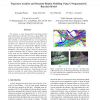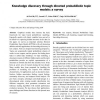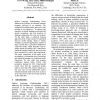41 search results - page 7 / 9 » Unsupervised Learning of Semantic Relation Composition |
EJC
2010
13 years 1 months ago
2010
We all use our associative memory constantly. Words and concepts form paths that we can follow to find new related concepts; for example, when we think about a car we may associate...
CVPR
2008
IEEE
14 years 8 months ago
2008
IEEE
We propose a novel nonparametric Bayesian model, Dual Hierarchical Dirichlet Processes (Dual-HDP), for trajectory analysis and semantic region modeling in surveillance settings, i...
BMCBI
2010
13 years 6 months ago
2010
Background: Word sense disambiguation (WSD) algorithms attempt to select the proper sense of ambiguous terms in text. Resources like the UMLS provide a reference thesaurus to be u...
FCSC
2010
13 years 4 months ago
2010
Graphical models have become the basic framework for topic based probabilistic modeling. Especially models with latent variables have proved to be effective in capturing hidden str...
ACL
2006
13 years 8 months ago
2006
Spoken Language Understanding (SLU) addresses the problem of extracting semantic meaning conveyed in an utterance. The traditional knowledge-based approach to this problem is very...



